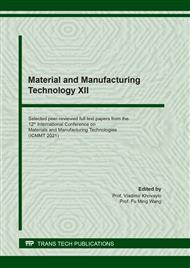p.15
p.21
p.29
p.39
p.45
p.51
p.57
p.63
p.71
Degradation of Virgin and Recycled Polylactic Acid/Eggshell Composites Buried in Soil
Abstract:
Development of polylactic acid (PLA) composites using various filler have extensively being been in focus. One of the possible natural filler is eggshell (ES) which are abundantly available derived from food industry waste. This work attempted to investigate the effect of eggshell (ES) filler on the degradation of virgin-PLA and recycled-PLA. The virgin-PLA/ES composites and recycled-PLA/ES composites were prepared using solvent casting method. The content of eggshell filler varied in the range of 0 – 20 wt%. Degradation of virgin-PLA/ES composites and recycled-PLA/ES composites were evaluated by soil buried test. After soil buried for 10 weeks, the maximum weight loss for virgin-PLA/ES composites was 14 wt% which noted at the composition of 95 wt% virgin-PLA/5 wt% ES. Nevertheless, for recycled-PLA/ES composites, the maximum weight loss observed at the composition of 90 wt% recycled-PLA/ 10 wt% ES at the value of 21 wt%. However, further addition of eggshell filler content in PLA/ES composites led to lower weight loss. Hence, the degradation of recycled-PLA/ES composites were more accelerated as compared to virgin-PLA/ES composites. The results revealed the potential of eggshell waste as a bio-filler in PLA matrix.
Info:
Periodical:
Pages:
45-50
Citation:
Online since:
August 2021
Authors:
Keywords:
Price:
Сopyright:
© 2021 Trans Tech Publications Ltd. All Rights Reserved
Share:
Citation:


